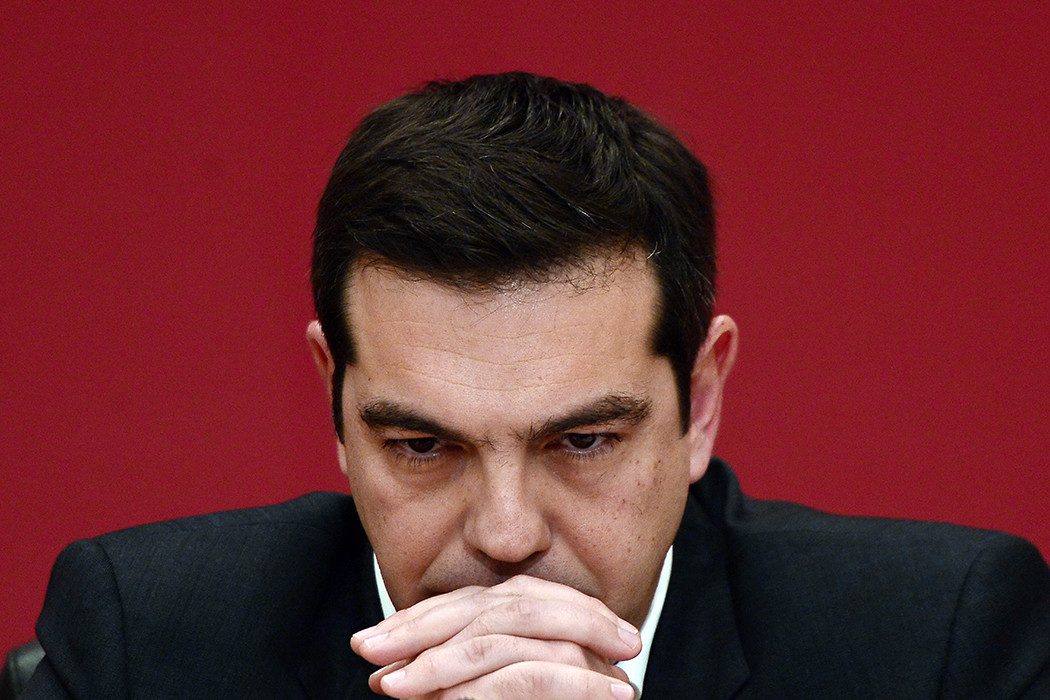Despite a historic “No” vote earlier this month, Greek PM Alexis Tsipras has capitulated to the demands of the troika, accepting an austerity package even harsher than the one that the people rejected. Jyotika Mansata and Tista Dutta explain how we got here.
- When Greece adopted the euro in 2001, it was far from meeting the Maastricht convergence criteria, a five-point “entrance test” that takes into account a country’s inflation, budget deficit, debt, exchange rate stability and long-term interest rates. This made it one of the weakest countries in the euro zone, and made it vulnerable to economic trouble when the economic crisis of 2008 broke out.
- Contrary to the notion that the crisis originated because the Greek government simply spent too much money and went broke, unable to repay the loans extended to them by banks, it was the banks themselves that pushed the Greek government into unsustainable debt. The deregulation of the financial sector and the change in structure of the European economy meant that banks could recklessly lend money across the continent, treating the debt of all euro zone countries as equal in risk, operating under the assumption that if push came to shove, the other euro zone countries would bail them out. That is what happened in 2010; it wasn’t Greece that was bailed out but the banks, who were protected from any losses their blatant speculation.
- In order to force the Greek government to accept massive debts, international bankers made interest rates on government bonds rise in the end of 2009, which made it more expensive for the country to borrow money or even just get by on existing bonds. Yields on the bonds almost tripled by 2010, which necessitated the first bailout package.
- In 2010, the Greek government passed three austerity packages at the insistence of the “troika” of international financial institutions: the European Commission, the European Central Bank (ECB) and the International Monetary Fund (IMF). The measures for these included a freeze in the salaries of all government employees, a 10 percent cut in bonuses, cuts in overtime for workers, a freeze in pensions, and an increase in VAT from 19 percent to 21 percent.
- On 2 May 2010, the troika approved a bailout package of €110 billion, allowing the troubled nation, which had faced three separate recessions between 2007 and 2009, to escape sovereign default.
- The bailout didn’t see an improvement in the condition of the economy, which underwent a severe depression, with the unemployment rate rising to the worst in Europe.
- In 2011, when Greek Prime Minister Georgios Papandreou refused to accept a second massive bailout, the banks forced him to resign, despite him having recently won a confidence vote in Parliament. Papandreou was replaced by Lucas Papademos, vice-president of the ECB. Similar events occurred in Italy and Spain within the next few days.
- A second bailout package was finalised in 2012. (Now that most of the original loans had matured or been repaid and their position was more secure, the banks agreed to a 40 percent reduction in face value of the remaining debt.) It brought the total amount of bailouts to €246 billion by 2016, which was 135 percent of Greece’s GDP in 2013. Three more austerity packages followed in 2011 and 2012, as conditions for the bailout. These were met with protests and violent clashes with the police in Athens.
- Because of its massive debt, Greece had to privatise and sell many of its profitable assets, including water, electricity, national banks, and telecommunications companies, to international corporations.
- In 2015, the Greek Parliament set up a Committee on the Truth about the Public Debt to investigate the causes for the accumulation of public debt. A preliminary report found the debt to be largely illegitimate. According to the report, the increase in debt before 2010 was not due to excessive public spending but due to the payment of extremely high rates of interest to creditors and loss of tax revenues due to illegal capital flow. The report also reveals how the first loan agreement of 2010 was used to rescue Greek and other European (especially German and French) private banks. Between 2010 and 2014, 89 percent of financial assistance paid out to Greece went back to the holders of Greek debt.
- The fiction of “Extend and Pretend”—extending the payback period, but pretending that all debts would eventually be paid—also contributed to the severe economic conditions. The true goal of lending to the debtor is not to be paid back with profit, but to keep the debtor in permanent debt, and hence, in permanent subordination.
- On 25 January 2015, the Synaspismós Rizospastikís Aristerás (The Coalition of the Radical Left, popularly known as Syriza) won a historic victory in snap polls to the Greek Parliament. Alexis Tsipras was sworn in as the new prime minister. His proposal requesting an extension of the bailout program, which expired on 30 June, and seeking a new €29 billion bailout was rejected by the European lenders, which led Greece to default on a €1.6 billion repayment.
- The new government rejected the austerity conditions that were added as a precondition for releasing the remaining funds from the bailout package. On 27 June, with negotiations deadlocked, the prime minister announced a referendum on the bailout agreement, to be held on 5 July.
- Currently, Germany and France own a majority of Greece’s debt. The austerity measures imposed by the troika have had devastating social and economic consequences. Since 2010, Greece’s GDP has fallen by 25 percent and the unemployment rate is 26 percent. Many legal experts argue that the harsh austerity measures could be considered a violation of human rights.
- Thomas Piketty, the French economist, was one of many decrying the harshness of Germany’s insistence on austerity. Throughout its history, Germany has never repaid its external debt. However, it has frequently made other nations pay up. In fact, the German Wirtschaftswunder or ‘economic miracle’ was based on the same kind of debt relief that they deny Greece.
- On 2 July, Greek finance minister Yanis Varoufakis made it clear that the referendum was about the choice between the continuation of the EU politics of the past that brought Greece to the edge of ruin and a new beginning that would provide a concrete plan to start the recovery of the Greek economy, and not—as had been earlier misrepresented—as a choice between the euro and the drachma, or one between Greece in Europe and a “Grexit”. On the same day, even the IMF concluded that Greece needed large-scale debt relief to get its economy moving.
- The Greek bailout referendum was held on 5 July 2015. Over 61 percent voted against the proposed austerity measures.
- On 13 July, European leaders and Greece reached a deal to bail out Greece and keep the country in the euro zone. Talks of a new assistance package would let the ECB provide badly needed emergency funding. However, the Greek parliament would be required to approve the terms without delay, which left Prime Minister Tsipras with just days to sell the deal to lawmakers and the electorate.
- The agreement would give Greece a chance to receive its third international bailout package (of €86 billion). But it would also require Greece to accept a wide array of measures including pension cuts, tax increases, and effectively subject itself to intensive international oversight to qualify for the aid.
- However, this left Tsipras championing the policies he had been elected to oppose. He no longer referred to the measures as “blackmail” or “hostage taking”, but said that they would help provide recovery potential. Ignoring the previous week’s landslide ‘No’ vote, the new proposal aims to cut €4 billions more than the austerity figured the people rejected. These moves by the supposed “anti-austerity” party may well achieve a new, deeper indebtedness for Greece, instead of the social justice they were promised.


